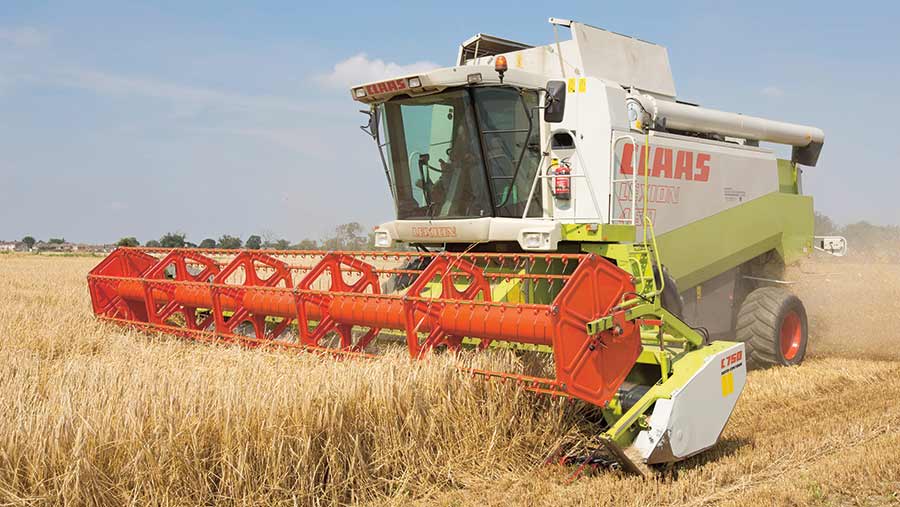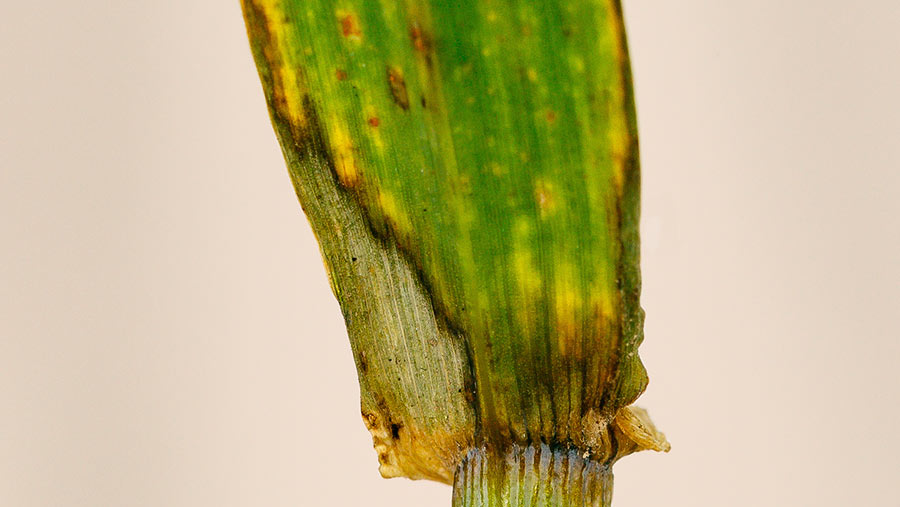Advice on how to tackle rhynchosporium in barley crops
 © Tim Scrivener
© Tim Scrivener Rhynchosporium commune remains the most important disease of barley in the UK, particularly in wet and high humidity areas in the West and North of the UK.
However, in wet seasons it causes problems across the arable area. Yield can be decreased by up to 40% and grain quality significantly reduced.
What about its life cycle?
Rhynchosporium is polycyclic, so is capable of causing several infection cycles during the growing season.
It is a challenging disease due to its ability to spread in a number of ways.
It first appears in winter barley during the autumn as infection foci caused by rain-splashed spores from infected trash, stubble and volunteers.
Research carried out at Scotland’s Rural College (SRUC) has shown that rhynchosporium is also seed-borne, with infected seed allowing the disease to develop inside fresh shoots and roots before expressing itself more evenly during January or February.
See also: Step-by-step guide for a tailored approach to crop nutrition
Visible symptoms are usually more significant at tillering, but wet summers can see infection splashed up the canopy and on to upper leaves and ears to infect grain.
In spring barley, symptoms appear much later – typically after tillering – and in wet years and weaker varieties can spread to upper leaves.
Wind also plays a significant role in the spread of rhynchosporium.
This route of infection is important where spring barley is planted adjacent to infected winter barley crops.
How can I identify the disease?
Rhynchosporium first appears as chlorotic, irregular or diamond-shaped lesions, typically around the base of leaves close to the stem.
Left unchecked, it develops into blue-grey water-soaked lesions on leaves and leaf sheaths.
Later in the growing season, mature lesions become pale brown with a dark purple margin (see picture) and coalesce to form large areas of dead tissue and destroy whole leaves or tillers.

Rhynchosporium lesion on leaf axil of leaf two of barley plant © Blackthorn Arable
What are the risk factors?
As rhynchosporium is a trash-borne disease, tight rotations pose a significantly increased risk, as do min- or no-till establishment systems where crop residues remain on the soil surface.
In parts of the UK where multiple or continuous barley is grown, risk is at its highest.
How can risk be managed?
Extending rotations minimises risk, so consider break crops. Where growing barley on barley, SRUC’s cereal disease expert Fiona Burnett suggests following winter crops with a spring sown crop to reduce disease carryover.
Other cultural measures include minimising trash, controlling barley volunteers in stubbles and avoiding early drilling in spring barley crops. Using clean, healthy seed stocks is also important.
Certified seed should be cleaner as parent crops are usually well managed.
Avoid using home-saved seed sourced from infected crops.
Varietal resistance to rhynchosporium has been improving in both winter and spring varieties and should be used as part of an integrated pest management strategy.
In the six-row category, all varieties have scores of 6 or 7 on the 2021-22 Recommended List, with top-yielding Belmont scoring 7.
Scores are a little mixed among two-row feed varieties, but there are 6s and 7s to choose from, including new highest yielder Tardis with 7. Both recommended two-row malting types have 6s.
Spring barley varieties have seen the most promising progress in rhynchosporium resistance.
With the malting market dictating which varieties are grown, favourites such as Concerto, with a score of 4, led to reliance on fungicides to manage the disease.
However, maltsters are now favouring the likes of Laureate (6) and Diablo (5), which Prof Burnett says gives much more room to reduce fungicide input in appropriate situations.
Which fungicides are effective?
As with any pathogen, the development of resistance to fungicides is a concern and rhynchosporium has been eroding the efficacy of the azole group for some time.
Despite the shift and continued heavy use in 80% of barley crops each year, azole prothioconazole is still working well, according to Prof Burnett.
This has been joined by new azole mefentrifluconazole, which along with SDHI fluxapyroxad is included in co-form product Revystar. Both actives are effective on rhynchosporium.
Strobilurins have also seen a slight reduction in efficacy, but remain an effective active group for controlling rhynchosporium.
With cyprodinil and spiroxamine also available, growers have plenty of choice and can use balanced mixes to control the disease, helping to slow the development of resistance.
Following the loss of chlorothalonil, the only multisite approved in barley is folpet.
As folpet has limited activity on rhynchosporium and there is a diverse range of modes of action to choose from in barley, it is not considered essential for resistance management purposes for this disease.
How do I build a fungicide programme?
For resistance management, the use of balanced mixtures is important and there is a good choice of azole, strobilurin or SDHI mixes as well as tank mix options.
Growers should consider using alternative actives to those used earlier. For example, switch to an azole-strobilurin at T2 if an SDHI-azole was used at T1.
For spring barley, typically a two-spray programme has been used in susceptible varieties such as Concerto in wetter seasons.
However, 2019 SRUC trials in what was a high-pressure year provided an insight into how improved rhynchosporium resistance in varieties can help manage the disease with less fungicide.
Very little response to T1 sprays at late tillering were observed in Faring (6) when compared with Concerto (4).
Prof Burnett sees varieties such as Laureate (also a 6) enabling growers to reduce dose or even eliminate the T1 spray at all but the wettest high-pressure sites.
This is with the caveat that other key diseases such as mildew, rust or net blotch don’t require management.
Ramularia can be managed most effectively at the later T2 timing so isn’t compromised by a decision to omit a T1.
Similar products to the winter crop can be used in spring barley, at about half dose, with prothioconazole the preferred base at T1 where risk dictates, in mix with either SDHIs or strobilurins.
View from the field – Patrick Stephenson, Niab Tag/AICC
Thick canopies, widespread barley volunteers and mild and wet weather has led to high levels of net blotch and rhynchosporium heading into spring.

Recent cold weather will have helped check disease, but the high background pressure means Yorkshire-based agronomist Patrick Stephenson still plans an early and robust start to fungicide programmes.
Looking at options, he says recent changes in product availability and efficacy of some actives will make decisions trickier this year.
Chlorothalonil and epoxiconazole have both been withdrawn and go-to product Siltra Xpro is no longer head and shoulder above the rest against rhynchosporium.
This reflects the slight efficacy slippage of its actives bixafen and prothioconazole seen in trials.
“It’s the first time in a while any significant changes in chemistry have been needed for its control.
“For many it will mean using a different SDHI component or using some strobilurin. Things are going to look slightly different to what we’ve been used to.”
Mr Stephenson will focus on three sprays over a nine-week period between late tillering and awns emerging.
A two-spray programme is historically more cost effective, but high background disease pressure and forward crops will inevitably see an earlier start to fungicide programmes.
Mr Stephenson says this will result in a longer period of protection being necessary, so growers should be prepared to deploy the additional spray.
The three applications should coincide with plant growth regulator (PGR) timings at late tillering-GS30 and GS33, and then follow up with a final spray as awns emerge from GS45-49.
In a typical season, spend would be split 40-20-40 across the three sprays.
Despite its slippage against rhynchosporium, Mr Stephenson still favours a prothioconazole base at the earlier two timings for its broad-spectrum control, including mildew and eyespot.
However, rather than relying on SDHI bixafen as a partner, fluxapyroxad may have a more prominent role early in 2021 for its strength on rhynchosporium.
Revystar is the newest available product, but its activity on ramularia is likely see it used as the last application when best control of the disease is achieved.
“It often boils down to cost and pre-formulated mixes tend to offer the better value over mixing straights. Also, be aware of cut-off dates of some SDHI products for later sprays.”
For spring barley, rhynchosporium pressure is largely driven by drilling date, with a trend towards earlier planting to maximise yield in south and east England increasing risk.
In these situations, a 50-50 split of an azole-SDHI combination at two timings (GS30 and GS39-45) using about 40% less dose than in winter barley would suffice, notes Mr Stephenson.
“But at more traditional drilling dates in late March or early April, it can be drier and the disease is less prevalent, so you may get away with one spray at the earlier timing.”
He adds that strobilurin insensitivity in net blotch and rhynchosporium has not increased as expected, so a more cost-effective option could be prothioconazole-fluoxastrobin mix Fandango.
At present, he does not see a justification to use Revystar due to its higher cost, so will rely on prothioconazole for a level of ramularia control in the absence of chlorothalonil.
“That may change if the weather dictates and crops become stressed, but at present I’m not too concerned about ramularia in spring barley.”

